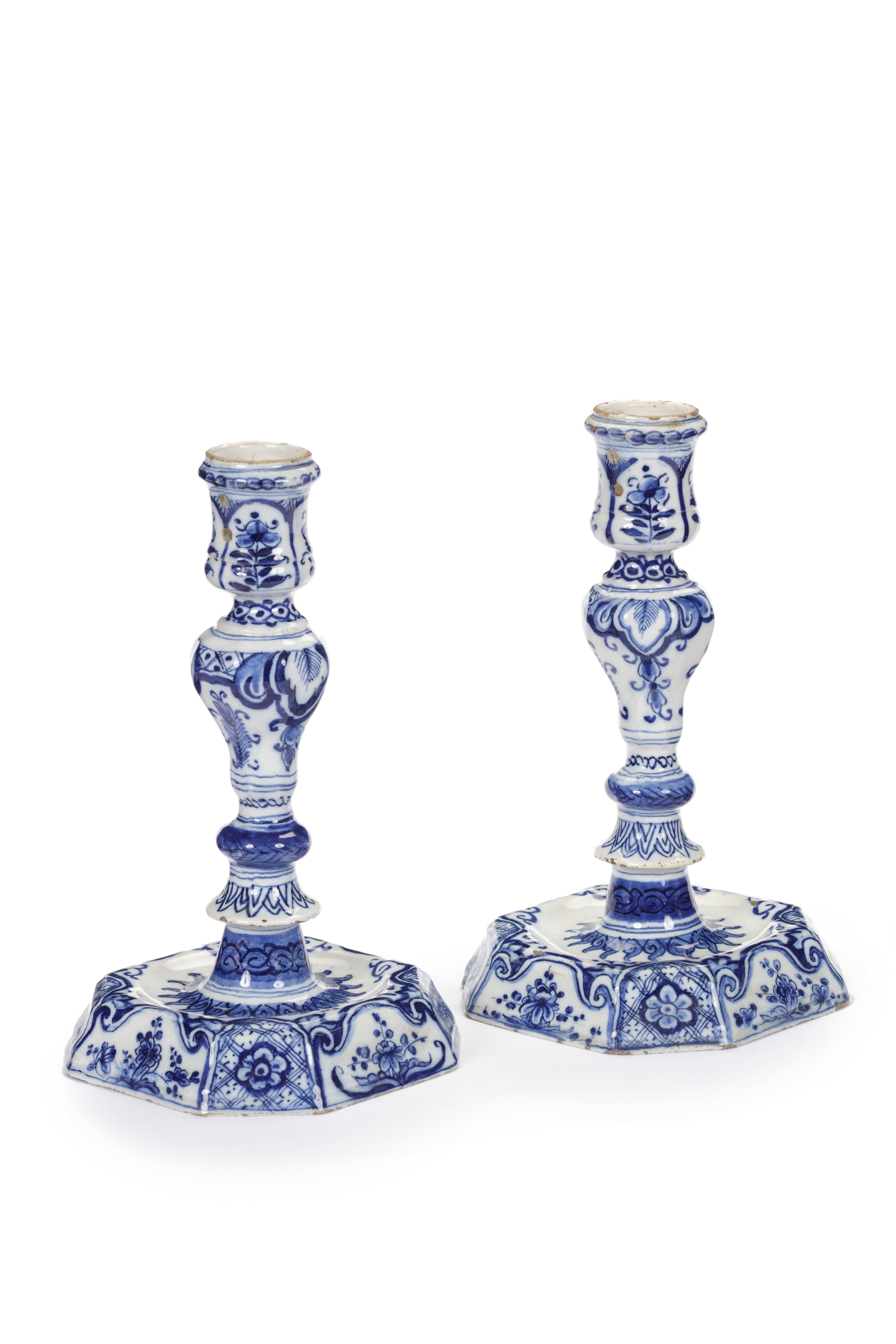[popup_trigger id=”13756″ tag=”span”]![]() [/popup_trigger]
[/popup_trigger]
Images on this website are licensed under a
Creative Commons Attribution-NoDerivs 3.0 Unported License.
OBJECT
•D2213. Pair of Blue and White Candlesticks
Delft, circa 1720
Each with cylindrical sconce painted with four panels with flowering sprigs and pierced with two holes for wax extraction, the inverted baluster knop stem with a lambrequin band and floral motives, the well encircled with demi-ruyi-heads, and the chamfered square foot with on the sides large panels of flowering sprigs and scrollwork, alternated by smaller panels of hatchwork reserved with a large flower head.
DIMENSIONS
Height: 20.3 cm. (8 in.)
PROVENANCE
Shelter Island Historical Society, sold to benefit the Museum Collections Program, probably since 1983
LITERATURE
Janet Roach (ed.), Delftware from the Gill Patterson Collection at the Shelter Island Historical Society, Shelter Island Historical Society, 2012, p. 6
NOTE
Before electrification, candles were the main source of light after dark. However, they were considered a luxury, even in the well-to-do home. Thus, the expression ‘the game’s not worth the candle’ highlights the fact that lighting a candle was like burning money itself. Tallow candles, made of animal fat, were the most commonly used candles. They emitted a foul odor and a black vapor, and burned very quickly. An expensive alternative was the beeswax candle, which had a more pleasant perfume and burned for a longer period of time.
Like the candles, their holders were also very expensive objects. Candlesticks gave a particular splendor to the parties and ceremonies of wealthy households. For example, candlesticks were placed in front of mirrors in order to increase the intensity of the light in French King Louis XIV’s Hall of Mirrors.
There are many types of candlestick, as they were the primary source of light in all households for hundreds of years. Originally, a candlestick was simply a cup or spike which held the candle upright and caught the dripping wax as it melted, so as to protect the surface which the candle was upon. During the seventeenth and eighteenth centuries candlesticks became much more commonly used, when dining habits changed, and the French style of eating later in the evening was adapted across Europe, there was more demand for ornamental candlesticks which would look impressive on the dinner table, as well as being functional. All sorts of candlesticks and candelabra were created, especially in silver. The height and grandeur of the candlesticks evolved through the desire to have a lavish item of silverware as the centerpiece to a table, whilst also benefiting from its practical use.
Silver however is a precious metal, which distinguishes it from wood, glass and porcelain which do not have any inherent value. Silver coins could be melted down for utilitarian and decorative objects, however the precious metal was not invulnerable to a changing economy. Silver was subject to the numerous fiscal crises of the late seventeenth and eighteenth centuries, especially in France. France’s involvement in expensive wars forced both Louis XIV and Louis XV to order all available silver (including the silver furniture at Versailles) to be melted down to replenish the country’s coffers. In the process, his silver service was replaced with a Chinese porcelain blue and white service. The melting of silver from grand houses encouraged the French faience industry to increase the production of both ornamental and functional pieces, worthy of royal and aristocratic tables. In their sudden need for such silver substitutes, the marchands merciers had to reach beyond the local factories to the potters in the other parts of Europe, and particularly in the nearby Netherlands.
It was for this reason, among others, that Dutch Delftware and other earthenware reached its highest level of production. The ceramic forms followed the shapes of the original silver objects and were made with the finest quality. As can be seen with this pair of candlesticks that was inspired on a silver example. The popularity of refined faience on the dinner tables of the European courts and noble houses increased the prestige of Delftware, and the pieces created at the end of the seventeenth century and the beginning of the eighteenth century came to rival and sometimes even surpass their silver counterparts.
SIMILAR EXAMPLES
Candlesticks of various shapes have been produced in Dutch Delftware since the 1680s. Some of the earliest examples are documented in the inventories of De Metaale Pot (The Metal Pot) and De Grieksche A (The Greek A) factories. These early candlesticks were sometimes executed in white Delftware, and of round, octagonal or square shape.









